RBSE Solutions for Class 7 Science Chapter 3 Separation of Substances are part of RBSE Solutions for Class 7 Science. Here we have given Rajasthan Board RBSE Class 7 Science Chapter 3 Separation of Substances.
| Board | RBSE |
| Textbook | SIERT, Rajasthan |
| Class | Class 7 |
| Subject | Science |
| Chapter | Chapter 3 |
| Chapter Name | Separation of Substances |
| Number of Questions Solved | 44 |
| Category | RBSE Solutions |
Rajasthan Board RBSE Class 7 Science Chapter 3 Separation of Substances
Textbook Exercise
Multiple Choice Questions:
Question 1.
Which process is used for separating out wheat from impurities?
(a) Winnowing
(b) Magnetic separation
(c) Hand picking
(d) Threshing
Answer:
(c) Hand picking
Question 2.
Which process is used for separating curd from butter?
(a) Distillation
(b) Centrifugation
(c) Sieving
(d) Vapourisation
Answer:
(b) Centrifugation
Question 3.
Types of homogeneous mixture
(a) Mixture of milk and sugar
(b) Mixture of sand and iron
(c) Mixture of soil and water
(d) Mixture of oil and water
Answer:
(a) Mixture of milk and sugar
Question 4.
Process of converting vapour into liquid is called
(a) Vaporisation
(b) Condensation
(c) Distillation
(d) Threshing
Answer:
(b) Condensation
Fill in the blanks:
1. Separating out gram from mixture of gram and wheat is called ……………. .
2. Conversion of liquid into vapours is called ……………… .
3. Soft drink is an example of ……………….. .
4. …………… water is used in making medicines.
Answers:
1. winnowing
2. Vaporisation
3. homogeneous mixture
4. Distilled
Match the following in Column A and Column B
| ColumnA | Column B |
| 1. Sublimation | (a) Mixture of sand andiron |
| 2. Sieving | (b) Mixture of salt and ammonium chloride |
| 3. Magnetic separation | (c) separating out dirty water from sand |
| 4. Vaporisation | (d) salt from sea water |
Answers:
1. (b)
2. (c)
3. (a)
4. (d)
Short Answer Type Questions:
Question 1.
What is lagoon?
Answer:
Lagoon is an area of relatively shallow, quiet water situated in a coastal environment and having access to the sea but separated from the open marine conditions by a barrier.
Question 2.
Explain homogeneous mixtures with examples.
Answer:
A homogeneous mixture is a solid, liquid or gaseous mixture that has the same proportions of its components throughout a given sample. Example: air, salt solution, squash etc.
Question 3.
What do you mean by filtration? Explain with diagram.
Answer:
Filtration is a process of separation compounds from a solid or liquid mixture is called filtration. Let us see how to separate insoluble impurities from dirty water. Tone a filter paper and fold it to make a cone as given in diagram. Place it in side a funnel. Pour the dirty water on filter paper slowly until 2/3rd part of funnel is filled. We will observe that filter paper will prevent solid impurities and all me only water to pass through it.
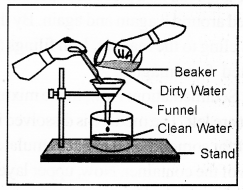
Question 4.
Explain the difference between homogeneous and heterogeneous mixture.
Answer:
A homogeneous mixture is simply any mixture that is uniform in composition throughout is called homogeneous mixture.
Example: sugar solution. A mixture that does not have uniform composition and properties throughout is called heterogeneous mixture. Example: oil in water mixture.
Question 5.
Explain the process of getting pure salt from impure salt with diagram.
Answer:
a china dish, fill it half with water. Add a spoon of salt in it and shake well. Impurities remain at bottom of the dish whereas salt dissolves in water. It can be separated by filtration. Now boil water as shown in figure. After sometime, we observe that water from china dish vaporises completely and salt is left behind in the china dish. This method of separating salt dissolved in water is called Evaporation
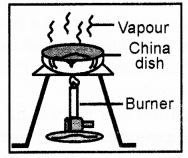
Long Answer Type Questions:
Question 1.
Write the process of separating out of sand, salt, iron chips from mixture.
Answer:
Following are the method to separate mixture of sand, salt and iron fillings/chips
Step 1:
Magnetic separation: First of all, the mixture is spread on a piece of paper and magnet is moved around it again and again. By this, iron fillings cling to the magnet. Iron filings are now separated from magnet.
Step 2:
Sedimentation: Now, in the mixture sand and salt are left. The mixture is dissolved in water and left for sometime., Sand accumulates at the bottom of the container. Now, upper layer of salt solution is separated by decantation.
Step 3:
Vaporisation: Now the solution contains only salt and water. Mixture is heated in a broad bottom container. Water is evaporated in the form of vapour and salt remains in the beaker. In this way, all the three components of the mixture are separated.
Question 2.
Explain with diagram any four techniques of separation?
Answer:
Techniques of separation:
1. Handpicking: Impurities like stones, soil present in wheat, pulses etc., can be separated by hand picking. The impurities are present in very less amount. Their shape and colour is different from wheat, rice and dal. These impurities are separated by hand. This process is known as handpicking.
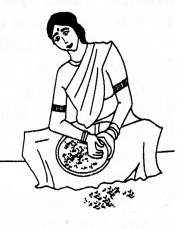
2. Sieving: Sieving is defined as a method in which two or more components of different sizes are separated from a mixture on the basis of the difference in their sizes. When flour is sieved before kneading, impurities remain in sieve.
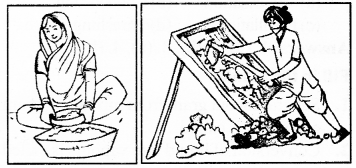
3. Winnowing: The process of separation of lighter particles from heavier particles; with the help of wind; is called winnowing. Chaff is separated from the grains by winnowing as chaff is lighter than the grains. Farmers drop the mixture of wheat and husk from a height. The husk is carried by the wind and form a heap at a small distance away. The wheat grains being heavier fall vertically to form a separate heap.
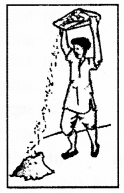
4. Centrifugation: Centrifugation is the process where a mixture is separated through spinning. It is used to separate butter and butter milk from curd. Curd is rotated is circular direction. Butter milk being heavier in weight goes down wards and lighter comes up.
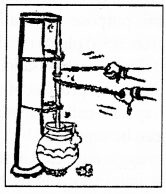
Question 3.
What is the importance of separation of substances? Explain.
Answer:
Necessity for separation of substances: The existence of any substance in its pure form is necessary. There are many substance which cannot be used due to presence of impurities in them. Therefore, to obtain a substance in its pure form separation is necessary. By separating impurities, we can increase quality, purity, strength and utility. At the same time, ratio of components of mixture can be estimated. For example, due to presence of impurities, strength of cement decreases. Lustre of gold decreases due to impurities. Impure water can cause diseases. Hence, we can say that it is very necessary to separate components of mixture.
Intext Questions
Question 1.
What is the difference between sugar and sand? (Page 24)
Ans: Sugar is a substance whereas sand is a mixture.
Question 2.
Write the components of mixture that are used in our daily life in the table given below: (page 24)
Answer:
Components of mixture used in our daily life are:
| S. No. | Mixture | Components |
| 1 | Air | oxygen, nitrogen, carbon dioxide, water vapour etc. |
| 2 | Jaggeiy | sugar and other extracts |
| 3 | Shoft drink | water, sucrose, acids, citrus peel or fruit pulp, caramel, carbon di-oxide, caffeine |
| 4 | Soda water | water and soda |
| 5 | Brass | copper and zinc. |
| 6 | Milk | water, protein, sugar and salt. |
| 7 | Blood | Water, haemoglobin, protein and other substances. |
Question 3.
If you are given mix of wheat, barley and com and asked to segregate the three then what will you do? (page 26)
Answer:
We will separate the mixture of wheat, barley & com on the basis of their identification by picking with our hands.
Question 4.
How can insoluble impurities like sand be separated from dirty water? (Page 2 7)
Answer:
By filtration.
Question 5.
You had seen separation of butter and butter-milk from curd in homes? How is it done? (page 28)
Answer:
With the help of centrifuge, butter milk forms lower layer and butter forms upper layer.
Question 6.
In homes, generally white naphthalene balls are kept for protection on woollen clothes. It has been observed that these balls disappear after some days. Why is it happened so? (page 30)
Answer:
It happens because of sublimation.
Question 7.
Why Potash alum is used in dirty water? (page 31)
Answer:
By alum, dirt settles at the bottom and clean water at the top.
Question 8.
How dissolved impurities can be removed from water? (page 31)
Answer:
Dissolved impurities from water can be removed by distillation.
Activity
Question 1.
Make the following mixtures and separate out basic components from them.
(a) Camphor + Salt
(b) Water + Baking soda
(c) Salt + Sand
(d) Sand + Iron chips
(e) water + Mustard oil
Answer:
Students make the adequate mixture and separate the components using the following techniques:
(a) By sublimation
(b) By vaporisation
(c) Sedimentation and vaporisation
(d) Magnetic separation
(e) By filtration.
Activity 2: (page 25)
Question 1.
What do you observe?
Answer:
It is observed that two different layers of water and oil are seen in the beaker.
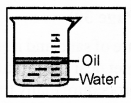
Conclusion: The mixture in which components of mixture are seen separately is called heterogeneous mixture.
Activity 7: (Page 31)
Question 1.
What do you observe?
Answer:
We can see that sand settles at the bottom of the beaker.
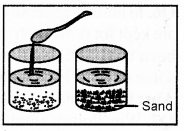
Conclusion: The process of settling of heavy particles down is called sedimentation. Sedimentation is the process of depositing sediment. The liquid left behind is called supernatant liquid. The act of decanting the supernatant liquid from a solid sediment is called decantation.
Other Important Questions
Multiple Choice Questions
Question 1.
Which of the following is a heterogeneous mixture?
(a) sugar solution
(b) aqueous solution of salt
(c) sand dissolved in water
(d) soda water
Answer:
(c) sand dissolved in water
Question 2.
The mixture of oil and water is:
(a) homogeneous mixture
(b) heterogeneous mixture
(c) solvent
(d) none of the above
Answer:
(b) heterogeneous mixture
Question 3.
Stones are separated from pulses by
(a) hand picking
(b) winnowing
(c) vaporisation
(d) none of the above
Answer:
(a) hand picking
Question 4.
Which of the following can be separated by filtration?
(a) purification of impure water
(b) salt from water
(c) iron fillings from sand
(d) all the above
Answer:
(a) purification of impure water
Question 5.
Salt can be obtained by sea water by:
(a) filtration
(b) winnowing
(c) vaporisation
(d) decantation
Answer:
(c) vaporisation
Question 6.
A farmer drops the mixture of wheat and husk from a height. The separation is done by which of the following method?
(a) filtration
(b) threshing
(c) sublimation
(d) winnowing
Answer:
(d) winnowing
Fill in the blanks:
1. Sugar is a compound whereas sand is a ………….. .
2. The substances present in a mixture are called …………. .
3. The process of separation of components from a mixture of solid and liquid is called ………… .
4. Magnet attracts ……………… substances towards itself.
5. The separation of salt and ammonium chloride is done by ………… .
Answer:
1. Mixture
2. components
3. filtration
4. magnetic
5. Sublimation
Very Short Answer Type Questions
Question 1.
How is a mixture made?
Answer:
Two or more substances mixed in indefinite proportion make mixture.
Question 2.
Write the types of mixtures?
Answer:
Mixture are of two types:
- Homogeneous mixture
- Heterogenous mixture
Question 3.
What do you mean by separation?
Answer:
Separation method process is a to separate two substances, that once formed a mixture.
Question 4.
Write any two methods of separation?
Answer:
- Filtration
- Vaporisation.
Question 5.
In which method of separation filter paper is used?
Answer:
Filtration.
Question 6.
Which substances are separated by magnet?
Answer:
Magnetic substances are separated by magnet.
Question 7.
Which method is used for purification of water by alum?
Answer:
Sedimentation and decantation.
Short Answer Type Questions
Question 1.
What is a heterogeneous mixture? Explain with examples.
Answer:
A mixture in which its components can be seen separately is called heterogeneous mixture. Example: oil in water or water in oil.
Question 2.
What is threshing? Explain with the help of a figure.
Answer:
Threshing is used for separating seeds from the harvested stalks. The method of separation is based on the fact that stalks of the crop plant and the chaff are soft materials whereas grains itself are hard. Being soft, stalks and chaff can be broken into pieces on beating on rocks or wooden planks but grains remain unaffected. Now a days, threshing machines are used for this purpose. Separation out of the food grains from dried plants is called threshing.
Question 3.
Explain vaporisation by giving one example.
Answer:
The process of conversion of liquid into vapour is called vaporisation. Salt from sea water can be separated by vaporisation. For this, sea water is collected in small areas called lagoons, water vaporises by heat of the Sun and salt remains in lagoons.
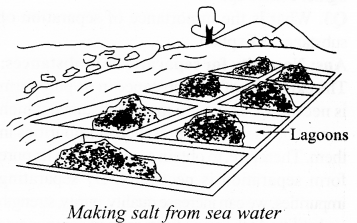
Long Answer Type Questions
Question 1.
Explain the following giving examples:
1. Sublimation
2. Sedimentation and Decantation.
Answer:
1. Sublimation: The change of solid directly into vapour is called sublimation. The solid changes directly into vapour on heating and on cooling again solidifies without changing into liquid.

Example: Separation of salt and ammonium chloride by sublimation.
2. Sedimentation and decantation: The process of settling down of heavier insoluble particles from mixture is called sedimentation.
Decantation: The process of transferring the clear and clean liquid without disturbing the sediments is called Decantation.
Example: This method ca be used to purify impure water.
Question 2.
Explain distillation, evaporation and condensation.
Answer:
- Distillation: Process in which the components of a substance or liquid mixture are separated by heating it to a certain temperature and condensing the resulting vapors.
- Evaporation and condensation: In evaporation, matter changes from a liquid to a gas. In condensation, matter changes from a gas to a liquid.

The method of obtaining pure liquid from a solution by evaporation and condensation is called distillation.
We hope the RBSE Solutions for Class 8 Science Chapter 3 Separation of Substances will help you. If you have any query regarding Rajasthan Board RBSE Class 8 Science Chapter 3 Separation of Substances, drop a comment below and we will get back to you at the earliest.